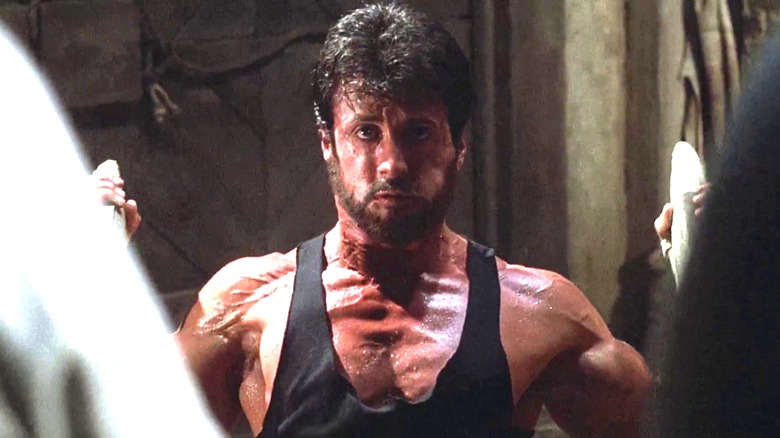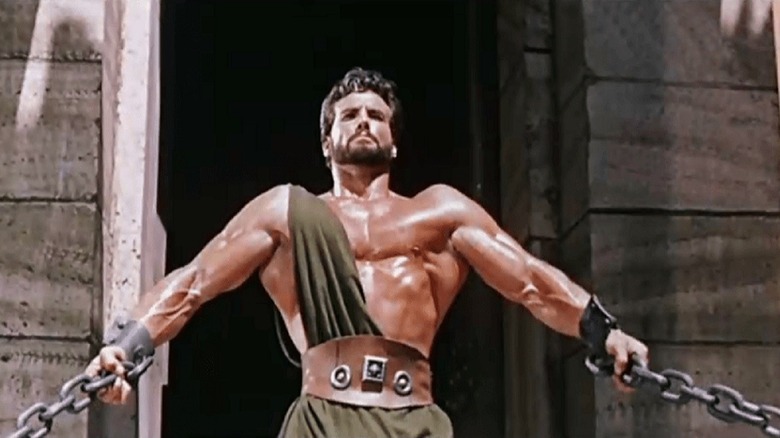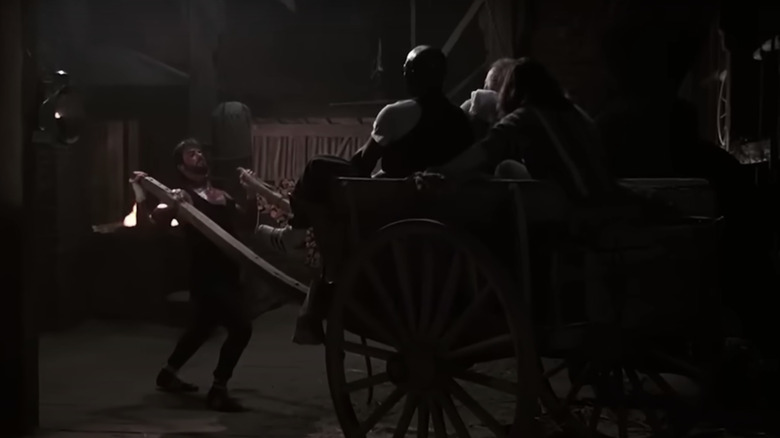Sylvester Stallone Used Rocky IV's Training Montage To Honor The Film That Made Him An Actor
Sylvester Stallone's 1985 film "Rocky IV" is quite handily the silliest in its series. Tapping into the ultra-jingoistic rhetoric of the Ronald Reagan era, "Rocky IV" saw its American title character squaring off against a Soviet super-athlete in a symbolic attempt to prove which of the world powers was ultimately stronger. /Film already wrote about the film's extended central training montage, claiming it to be one of the best of all time because it provides a parallel between the way Rocky (Stallone) trains, and the way the evil Russian Ivan Drago (Dolph Lundgren) trains. Rocky is out of his element in Russia, where his bout with Drago is to take place. Because of this, Rocky has to find clever, low-fi ways to build in strength, including hauling logs and pressing rickshaws full of locals. Drago, meanwhile, is locked into a high-tech, computer-run athletics facility where his muscles and strength are meticulously measured down to the tiniest units possible.
It's high-tech, vs. low-tech. It's Soviet soullessness vs. American tenacity. The symbolism is about as subtle as having your face slammed into a kettledrum.
"Rocky IV" was eventually and widely lambasted for how ridiculous it is — many might immediately think of the human-sized robot built to serve drinks to Paulie (Burt Young) — and Stallone re-cut the film in 2021 as "Rocky vs. Drago." The new version left out the robot and shortened the film into something slightly better. The training montage remained. In a making-of video about "Rocky vs. Drago," available on YouTube, Stallone pointed out that one of the shots in the famed montage — the shot of Stallone lifting the rickshaw — was included as a deliberate homage to one of the director's favorite screen performers: Steve Reeves, better known as one of cinema's great Hercules performers.
We can take in an old Steve Reeves movie
Pietro Francisci's 1958 film "Hercules," starring Steve Reeves in the title role, might remain the high water mark in the peplum genre. Throughout the 1960s, Italian action/fantasy epics set in the ancient world were very much in vogue, and all of them starred bodybuilders and athletes. One might say they were the offspring of Johnny Weissmuller's "Tarzan" films from 30 years previous. Each of these films featured oiled, burly men performing great feats of low-budget derring-do, including fighting animals and destroying buildings. Mythic heroes like Hercules, Maciste, and Goliath regularly appeared throughout the genre. In the modern era, the films have acquired camp appeal for their dumb writing, and many of them have become guideposts for queer cinema; there's a reason why Dr. Frank N. Furter recommended watching an old Steve Reeves movie in "The Rocky Horror Picture Show." Where else can one see so many oiled, burly men?
"Rocky IV," with its focus on the male physique and mythic heroes, might be considered a modern peplum film. It's not set in ancient Greece, but it is about a Hercules-like hero, Rocky, battling an equally powerful mythic villain, Drago. Stallone certainly seems to feel this way, as the "Rocky vs. Drago" commentary reveals Sly's affection for Reeves. In his words:
"Steve Reeves, the guy that started me out, like this skinny kid and really thin. I was dodging school at 12 years old. I went to a theater and they were playing 'Hercules.' He's coming out of the temple and he's been chained up and he whips his chains and he pulls. And it's this really iconic shot. Literally, my mind exploded. It changed my life, I literally came out of there with a purpose."
Rocky vs. Hercules
Sylvester Stallone recalled his experience watching "Hercules" so sharply, that he wanted to recreate that moment in "Rocky IV." He wanted to be Hercules, and, in a way, he was. He looked to Steve Reeves as an idol, a physical ideal to look up to. Stallone built himself up to look like a matinee idol, and he succeeded. He said:
"I wanna be that. So when people say their films influence, absolutely. If you're gonna to the theater and your mind is open, but there's still some questions in your soul, about something, about your life, and all of a sudden your dilemma is played out on the screen it just resonates."
A moderator asked Stallone where he saw "Hercules," and he recalled that it was the Silver Theater in Silver Springs, MD. He went by himself and recalls the experience vividly. He ran out of the theater, and a career in bodybuilding unofficially began. "I went from that movie theater right to a junkyard," Stallone said, "and started lifting brake things or axles, you know? Like pieces. Not big, but enough. And I took a couple of pieces home and tied them together with ropes and I just started lifting junk. That was the beginning, and I never looked back."
Stallone's low-fi lifting techniques as a 12-year-old would in fact translate directly into what Rocky Balboa did on screen in "Rocky IV." Sometimes, it seems, improvisation is the best tack. And while Stallone has never played Hercules, he did once paint a painting called "Hercules O'Clock," seen on his Instagram account, which is meant to visually represent his ambitions as a 12-year-old. Steve Reeves, it seems, has never left him.


